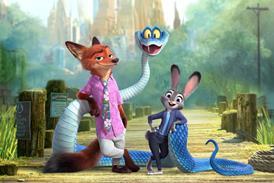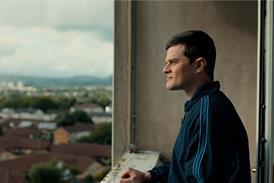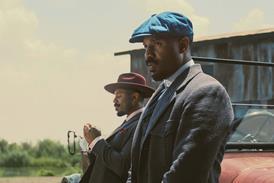Last December, Bettina Sherick, executive vice-president of international digital marketing at Twentieth Century Fox, sat down with her team and said: 'This is the year we figure out how to make all our content portable.'
Aware that web browsers are no longer drawn automatically to a film's official website and that the online community is increasingly setting up camp on social networking sites such as MySpace, Facebook, Bebo and Orkut, Sherick knew she should follow the migration.
Her call is symptomatic of a broader recognition of the marketing significance of social networking sites by the industry.
Sites such as MySpace and Facebook not only interactively build fan enthusiasm pre-release and spread rapid word-of-mouth post-release, they have begun to assume TV's role as the experience audiences share with their friends.
'The old 'water-cooler' moment chat about last night's episode of Pop Idol now takes place live as communities swap opinion,' says Giles Hadman, vice-president of advertising and media at Walt Disney Studios Europe.
'People are engaged with those social networking sites throughout the day,' says New Line president of domestic theatrical marketing Chris Carlisle. 'You learn a lot of information about what they like and don't like. It's much more pull than push. You put stuff out there you know they're going to be interested in.'
It is only this year that MySpace and Facebook have made a concerted effort to convince studios and independent production companies to tap into their vast user networks under an organised system.
Worrying for some, perhaps, is the sheer volume of marketing interest. Within 24 hours of Facebook announcing its new advertising initiative, nearly 100,000 brands had created their own pages.
However, research suggests people who use social networking sites do not want in-your-face advertising. They want a film brand to provide them with something that is going to make their lives better or give them an extra piece of content.
Indeed, the challenge is how to stand out. The JJ Abrams-produced disaster movie Cloverfield has deployed an admirable viral campaign that has web-based movie fans hooked ('alpha fans', as Amy Powell, Paramount's senior vice-president of interactive marketing, brands them).
'We've been having fun letting the fans own the campaign,' says Powell, 'and it's been working extraordinarily.'
The social networking portion of Paramount's Cloverfield campaign starts in mid-December when it launches on Facebook the first significant clip from the movie, which will also translate to other networking sites.
But marketing campaigns not only have to cultivate communities in several languages; the sites themselves are built on different technologies, which mean daunting technical challenges.
'It's not one-size-fits-all,' says Fox's Sherick. 'We tailor content differently depending on the country and social-networking site.'
The knee-jerk reaction is to target the youth market. But with many industry people saying they now check their Facebook profile before their personal e-mails, the reach is spreading.
Older-skewing titles can also benefit from a community strategy, as in the case of Twentieth Century Fox's The Darjeeling Limited, which targeted Facebook's affluent, educated demographic in the US with a page that supplied news updates, exclusive video clips and interviews.
The Darjeeling-linked short, Hotel Chevalier, spread across the web through network communities, banner advertising and Apple's iTunes, and had more than 500,000 downloads in two weeks.
Whereas in the past, value was judged by how many members became 'friends' with your movie's profile, the goal is now about encouraging users to distribute applications and original content. 'It's a great way to gain advocacy,' says New Line's Carlisle, 'and have users become ambassadors for your movie.'
One unanswered question is to what extent such sites drive people into cinemas. With youth-targeted comedies such as Borat and Knocked Up, the brand-building that was created on the web, particularly though the films' MySpace pages, was palpable.
Fox spearheaded huge activity for Borat, building pre-release buzz by holding preview screenings in five countries on the same day for friends of the film's MySpace page.
Companies can monitor buzz to ensure their message is getting across, making amendments on paid-for ads in real time if necessary. But in terms of online's genuine contribution to a campaign, it is less straightforward.
Is a streamed trailer more valuable than a text-based interview with major talent' 'It's a really hard line to draw,' says Sherick. 'But I will say that, anecdotally, where we have a lot of buzz or community around a particular title, we see those films perform at the box office.'
The scale and marketing spend determines what the networking sites can do for a film on their platform, so it is no surprise the deeper-pocketed studios have so far proved better at exploiting the relationship.
Warner Bros' 300 had a sponsored technology launch - allowing users to increase their photo upload facility threefold to 300 photos by becoming friends with the page. 'Something like that encourages the MySpace community to engage,' says MySpace's head of entertainment for Europe, James Fabricant.
Such increased functionality is successful because users receive something for free. But while studios have come up with compelling strategies, independents have arguably been less successful at capitalising on networking sites, ironic when The Blair Witch Project was the original internet marketing phenomenon.
And internet campaigns have not always delivered when it comes to audiences versus internet hype, as Snakes On A Plane's box-office flop proved.
'There are a couple of films where we spent a huge amount of money on these sites and I just don't know how much added value we actually got,' says Carlisle. 'You need to temper the instinct to go to those places with how much you spend. I think everybody's taking a more sober look at it.'
One executive reveals it costs $500,000-$1m per day to do a sponsored take-over of the MySpace homepage. But while it may be expensive, MySpace views itself as a partner in the studios' success, and insists it is working to help studios engage their users in a dialogue.
In turn, studios understand that offering exclusive assets for a film puts them in a stronger bargaining position, with most studios setting up annual deals with the major networking sites, as well as portals such as Yahoo.
'Exclusive assets from the film, including interviews with the stars, are the currency that works well on all those sites,' says Carlisle. 'You can trade on that, because a lot of these sites are getting very expensive. If you want to create an event on MySpace, it's a huge amount of money.'
'We have reams of data that we gather about every single movie,' says Paramount's Amy Powell of the networking phenomenon. 'It allows you to be flexible with your campaign so you can continually finesse.'
Powell's recent campaign for Sweeney Todd: The Demon Barber Of Fleet Street included an online featurette showing Johnny Depp recording one of the film's songs, positioning a long-lead takeover of MySpace's homepage and uploading the Depp teaser onto the movie's profile. 'The MySpace team was floored by how fast we grew,' says Powell.
With social networkers defining themselves by their likes and dislikes, marketing people can already pinpoint members based on their love of a particular genre. MySpace launched a service for advertisers targeting users based on movie genres this month.
But some advocate caution in approaching social networkers. 'A film distributor could target users directly with an advertising message,' says Peter Ruppert, founder of London-based Entertainment Media Research. 'But it's unproven because it's only just started happening. If you just send them an irritating pop-up, they're probably going to be annoyed and write about your film negatively. There is a danger of upsetting these people.'
CASE STUDY: KNOCKED UP
Embracing the culture
To place a brand on a site that exists essentially to help friends communicate can be risky. Key is the ability to embrace the culture of the particular social network without being intrusive. That is where Universal triumphed with its campaign for Knocked Up.
With the movie's social dilemmas handled in a comedic way, it was the perfect candidate for a community site campaign. Universal established a MySpace custom community that housed the trailer and introduced the characters, with chatty profiles and games that played on the film's premise of an unplanned pregnancy. In a game called Baby Maker, users could upload pictures and deploy morphing technology to see what the hypothetical offspring would look like.
Such games enticed people to hang around longer than it takes to watch the trailer. 'If people are interacting with your brand for 20 minutes,' says Neil Wirasinha, Universal Pictures' director of international advertising/media, 'the impact is completely out there when compared to a 30-second TV spot.'
The sites also helped Universal position Knocked Up to a younger market. And it was not just MySpace. Universal created a Facebook application with the agency Hyper Happen called Shag-Marry-Kill, where profile pics were rated among friends.
Conducting exit polls on Knocked Up's opening weekend, Universal found that, for young men under 25, the film's MySpace presence equalled friends' recommendations as the reason they had seen the film at 15%, a huge currency for the studio and only 11% behind the effect of the film's TV campaign - where ad spend was 200% bigger (the MySpace campaign represented 3% of Universal's media budget).
'It really helped our opening weekend and with the continued business, because the hits we were getting after opening were really strong,' says Wirasinha.
THE DISCOVERY CHANNEL
A new generation of film-making talent is coming to the fore, courtesy of MySpace. Matt Mueller reports
Since its inception, MySpace has viewed itself as an entertainment platform that connects people, content and culture. MySpace built a film channel early on to provide film-maker-specific functionality over and above the normal user profile, and now claims the largest film-making community in the world (100,000 profiles). Like the music channel, which has launched acts such as Lily Allen, it is independent and aspiring film-makers who are drawn to MySpace as a platform to network with like-minded people.
So it is no surprise MySpace is creating closer ties to film production. UK producer Livia Giuggioli sought out MySpace for Marc Evans' documentary In Prison My Whole Life, about death-row inmate Mumia Abu-Jamal, because she felt they could help build the buzz she wanted. 'We didn't want to go the traditional ways,' says Giuggioli. After seeing a rough cut, MySpace's director of entertainment for Europe, James Fabricant, agreed to support the film through a marketing partnership that will give $102,000 (£50,000) worth of MySpace publicity (media value being the company's main currency) to the UK distributor that purchases the film.
But more momentous is the MyMovieMashUp competition for UK film-makers, which was established to launch its UK movie channel. Pitched as 'the world's first user-generated feature film', the idea was to create a film from start to finish through user interaction and collaboration. Vito Rocco was awarded the director's chair for David Lemon's script, Faintheart, a romantic comedy set in the world of battle re-enactments, after a four-week online voting process that pitted his short Goodbye Cruel World against 800 others. The films were viewed 800,000 times, with 500,000 votes cast.
Parts of the shooting script were also put online for user feedback, while minor roles were cast on MySpace. And five bands have the chance to record the soundtrack. Although MySpace's production partners on the film - UK producer/distributor Vertigo (which has a track record of working with MySpace on such films as Dirty Sanchez: The Movie), Film4, UK mini-studio Slingshot and the UK Film Council - put up the $2.1m (£1m) budget, the media value MySpace is supplying is invaluable.
'It's challenging traditional notions of film-making and potentially creating a new model,' says Fabricant. 'Everyone's watching really closely to see how it goes.'
As with music, MySpace is also proving useful as a talent filter. Wild Bunch snapped up the $2,000 homemade horror film Pop Skull from UK director Adam Wingard's MySpace page when Wild Bunch's acquisitions executive Jerome Rougier stumbled across the trailer while surfing the web and asked the producer to send him a screener. Wild Bunch started selling Pop Skull at the recent AFM. 'It's more about the discovery of a talent,' observes Rougier. 'There are movies made for $5m that don't look as good as this.' Rougier believes he was lucky to find Pop Skull when he did, having ploughed through his fair share of rubbish on MySpace too.
FACTS & FIGURES
1.5m number of hits on Transformers' MySpace page in the first week
200,000 number of trailer views on Knocked Up's MySpace page in the first three days
107m MySpace unique worldwide users*
73.5m Facebook unique worldwide users*
19.7m Bebo unique worldwide users*
*September 2007.



















No comments yet